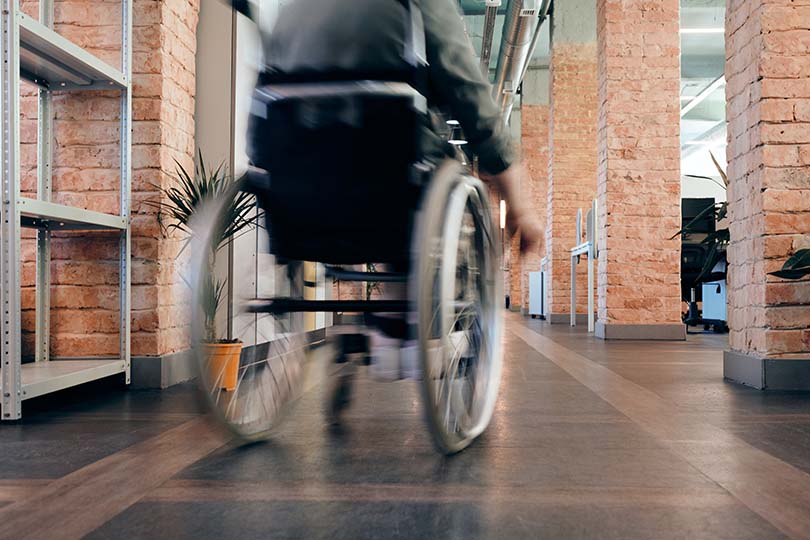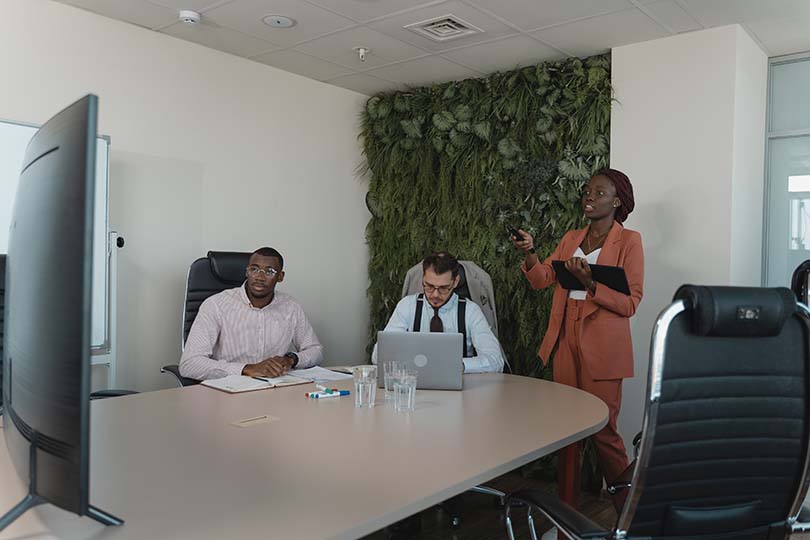
Conducting usability testing with people with disabilities
February 7, 2023If you’re testing your products with people without disabilities, why shouldn’t you test them with someone who’s blind, deaf or dyslexic? They have an equal right to check the products on your website, add the ones they want to the cart and pay what they purchase, without needing the help of a friend or a family member. If they aren’t able to do that, they’ll simple turn to a competitor who offers a more accessible website.
Why conducting usability tests with people with disabilities?
When 15% of the world’s population lives with some kind of disability (Source: WHO) it doesn’t make sense to exclude them from the usability tests of product. It’s like you’re ignoring 15% of your target market. Not to mention the growing number of aging users, who develop vision, hearing, motor and cognitive limitations and will also benefit if a product is built without any barrriers.
Even if the website was designed and developed in conformance with the accessibility guidelines, people with disabilities might still not be able to accomplish the necessary tasks on the website. Testing with a greater diversity of users will make all the difference for the website (and for the business). Not only are you making it available for a larger number of people with purchasing power, you’re also increasing the chance of turning them into customers.
Drawing on our experience conducting usability tests with users with disabilities, we’re sharing a few things to take into account when planning and conducting research with people with disabilities and make sure everything goes smoothly and you can collect valuable insights.
How to recruit users with disabilities?
When running usability tests with people without disabilities we know there are those who are tech-savvy and those who struggle a bit more when using digital products. When it comes to people with disabilities the same happens. People who are blind can be more or less comfortable using screen readers. It’s important to test with regular level users, not just experts in accessibility and assistive technology.
If you’re not working with a recruitment agency, there are a number of places where you can find people with disabilities willing to help you:
- Online communities for people with disabilities;
- Advocacy groups and charities;
- Organisations and agencies who provide training and other services to people with disabilities;
- Seniors organisations and local senior centres.
Don’t assume that one participant with a disability represents all
If you’re on a budget you’ll probably feel forced to invite people with different disabilities — one person who’s blind, one person who’s deaf, one person who has a motor disability and other with a cognitive disability. However you should be aware that that’s not a representation of everyone with similar disabilities.
A blind person is not a representation of everyone with visual impairments.

Photo by Mikhail Nilov in Pexels
As there’s different types of visual impairments, people use different interaction techniques, adaptive strategies and assistive technology configurations to navigate the web. While someone might use VoiceOver on Apple devices, someone using Windows will use NVDA for example, or they might even use a braille display. If a person has low vision they might set colour preferences for high contrast mode or set up a bigger font size.
While the ideal would be testing with several people with different visual impairments, reality is budget and time don’t always allow that to happen.
You need to adjust the participants you recruit to the product you’re testing. If you’re testing a product without any audio information or speech functionalities then you won’t need to recruit users with auditory impairments. If you’re testing a university app and your user analysis reveals there will be a lot of people with dyslexia using it, then you should include people with this disability in your testing.
Also, don’t assume that people with disabilities can’t or won’t use your product. If you’re testing a website for a car brand, don’t exclude people who are blind from the usability testing just because they aren’t able to drive. They might be looking to buy a family car or as a gift for their children.
Where to conduct the usability tests?
Depending on their disability, for some people it might be an issue getting to the research lab. A participant with mobility issues might feel more comfortable in their own home or a place they often go to, like a cafe or school.
While conducting the tests in the lab makes it easier to record the session and having the project team joining in to observe, the best thing to do is finding out where the participant would prefer to do the test.
If you decide to conduct the usability tests in-house, you need to make sure your lab is accessible:
- Check if the entrance of the lab and the building has any steps or if there’s a working elevator available;
- Check if the doors are wide enough for a wheelchair to fit in, as well as if it can fit under the table where the testing device is in (at least 70cm high);
- Check if the room is large enough to accommodate a service dog, a caretaker or a sign language interpreter;
- Check if the toilet is accessible.

Photo by Marcus Aurelius in Pexels
If you’re welcoming a participant with a visual impairment, offer to guide them or ask how they would like to be guided. Let them know if there are any obstacles (steps, furniture, plants) and what’s on the desk (devices, a bottle of water, napkins).
You can also offer some assistance with booking a taxi to pick them up or meet them in front of the building to guide them to the office.
Remote testing is can also be a good option to avoid any complications participants might experience with getting to the lab.
If you’re working with people with disabilities, check these general rules of etiquette for interacting with people with disabilities.
Which devices should the participants use?
While for people without disabilities is pretty much indifferent which device they use to complete the tasks, for a user with some form of disability that’s not the case. They normally have their computer and smartphone configured a certain way and with the assistive technology they normally use.
Allowing the participant to use their own device will be less costly. There’s a multitude of assistive devices and softwares, and while some are free, acquiring some of them would represent a big investment. For example when it comes to screen readers, while one participant might use NVDA, which is free, other might use JAWS, a paid software ($90 a year or $900 one-time purchase). On a similar example, if a blind participant uses VoiceOver on Apple products, they might struggle if they have to complete the test in a Windows device.
Having the participant bringing their device will also be less time-consuming. Although you still have to allow some time at the beginning of the test for them to set everything up, it’ll probably be faster than having them setting up their preferred configurations in the lab devices.
💡 Tip: If you’re testing with screen reader software, ask if the participant can slow down the speaking rate. This will make it easier for the moderator and anyone observing the test to understand where they user is at. You’ll be surprised with how fast they have it set!
Is the website accessible enough to be tested?

Photo by Christina Morillo in Pexels
The last thing you want is having a person with a disability coming to your office just to realise the website is not accessible enough to be tested.
From running the website through an automated tool or doing some manual checking yourself, here’s a few things you can do:
- Try using a screen reader to see if the website is correctly read. Look for incorrect reading order or tags and images without helpful alt text, for example.
- Navigate the website using a keyboard by clicking the tab key. If no element of the website becomes focused it won’t be possible for someone with a motor disability that prevents them to use the mouse to navigate the website.
- Check colour contrast between the text and the background. If there’s a low contrast it will be harder to read by a participant with low vision.
- Conduct an accessibility audit against WCAG 2.1 guidelines.
- Conduct usability testing with users without disabilities first. This will help you to correct any obvious technical or usability issues with information architecture, navigation or content. If they represent a problem to users without disabilities, they are probably an ever bigger problem for a user with a disability to overcome.
Schedule the right amount of time for the testing
It’s only natural that people with certain disabilities take longer to complete the test tasks (specially if the website has severe issues) when comparing with a regular user.
The disability itself, medications, and the extra effort to use assistive technology are some of the factors that can influence the time it takes for the user to complete the test. You’ll want to avoid user fatigue. They might not be able to attend a long session or might need to take some breaks. People with tremor or loss of fine motor control might take more time to do basic tasks like clicking a button. A person with dyslexia might need more time to process textual information.
There’s not a one-size-fits-all, you should take into consideration each participant and their particular needs. The best thing is to have a shorter task list and prepare additional tasks if there’s time and the participant doesn’t mind going through a couple more.
Besides planning more time for the test session, it’s also better to plan for more time before and after the test. Plan time at the beginning of the test for the participant to set up any assistive technologies and configure settings as they wish. Then plan more time in-between sessions as you might need additional time to pack the participants devices and help them leave the building.
Moderating the test session
All documents you provide to participants such as the consent form, non-disclosure agreement, instructions and directions, tasks or forms should be in clear and simple language, specially for participants with cognitive disabilities. You should also consider the best way to send or hand out the documents, based on each participant ability. They might prefer to receive it by e-mail (accessible HTML, PDF, plain text), printed in large font or in braille, for example.
At the beginning of the test, it’s very important to reinforce that it’s not the participant that’s being tested, but the website. They are probably doing it for the first time and assuring you’re not assessing their skills or abilities might make them feel more at ease.
Ideally you should use the same tasks for users with and without disabilities. However, while in a regular test the moderator should help the participant as little as possible, with users with disabilities it might be necessary to intervene a bit more.
Be prepared to adjust. When testing with users with intellectual disabilities you should be ready to explain the task a bit better to ensure they understand what they have to do. If you’re using rating scales, use plain language and rather than using a 7-point scale, keep it simpler with a maximum of 5-point.
Bring the team to observe the testing

Photo by Tima Miroshnichenko in Pexels
There are many people who have never seen a blind person using a computer or smartphone with a screen reader. For people to design and develop with accessibility in mind they need to be aware of the specific needs of people with disabilities when navigating through a website.
Calling different members of the team — designers, developers, content writers — will allow them to see how people with disabilities actually navigate the web, hearing first-hand about the issues they struggle with. For some it will certainly be a wake up call.
. . .
More usable and accessible websites for all users
When you make your website or app accessible you’re not only improving the experience for people with disabilities. Elderly people, someone with a temporary or situational limitation and users without disabilities will benefit.
Having a product that checks all accessibility guidelines is not enough. Testing it with real users, with real limitations, will uncover the real usability issues they struggle with.
. . .
📚 Useful resources:
- Just Ask: Integrating Accessibility Throughout Design — a comprehensive book about accessibility, available online, with a useful chapter on usability testing.
- “Accessibility — Creating accessible digital experiences” — a white paper where we cover disabilities and barriers to web accessibility, best practices to build accessible websites, and more.
- “Web Accessibility” — an infographic we created to raise awareness for web accessibility to celebrate the International Day of Persons with Disabilities.
Want to offer a service accessible to everyone?
Accessibility testing doesn't need to be daunting. For the past years, we've been conducting usability tests with people with disabilities and grown our expertise in that area. If you need some help understanding how users with different abilities experience your product reach out to us.
Tell me moreRelated Articles
-
Digital Accessibility Strategy Course [starts in January 2025]
The new Digital Accessibility Strategy course aims to equip participants with the essential skills to understand the digital accessibility landscape.
-
Looking to be EAA compliant? — Don’t fall for easy web accessibility solutions
Choosing an overlay is just a band-aid solution, and shows a true disregard for users with disabilities. Instead, we need to work towards a mentality where websites, apps and other digital products are designed and coded with accessibility in mind from day 1.
-
A glimpse into the future — Here’s the UX design trends we expect to dominate 2024
Emerging technologies and tools constantly influence the way people use the Internet and interact with digital products. And as user behaviours and preferences evolve, designers must keep up with new tools and solutions to deliver interfaces and user experiences that cater the needs of an ever-demanding audience.
-
How can insurance companies make their digital products more accessible?
Millions of people who live with a disability struggle to access important information online because websites and apps are built with major content and technological barriers. And insurance websites are not an exception.
-
Barrier-free banking - From branches to mobile apps accessible for all
In the banking and financial industry, accessibility is about empowering everyone, including people with disabilities and the elderly, to enjoy bank's products, services and facilities, by making them convenient and easy to use.
-
Design for a better world - How working together and applying design approaches is improving people's lives
9 November is World Usability Day 2023. This year's theme is Collaboration and Cooperation, which intents to focus on how we can work together to create solutions, both globally and locally, to solve the world's biggest problems.
-
Be an Agent of Change - Check these resources to help you build more ethical designs
The role of today's designer goes far beyond simply creating beautiful interfaces and experiences. You can no longer design without considering the consequences of how what you're creating impacts individuals, society and the world.
-
E-commerce and Accessibility - Creating an inclusive online shopping experience
Now it’s the time for online stores to improve their website accessibility and ensure they offer an inclusive experience for everyone.
-
The future is today — How can we leverage AI to improve our UX Design work
AI has now become a big part of several areas of our lives, and UX Design is no exception. It’s actually becoming more and more applicable to the UX design process.
-
Conducting usability testing with people with disabilities
Drawing on our experience conducting usability tests with users with disabilities, we’re sharing a few things to take into account when planning and conducting research with people with disabilities and make sure everything goes smoothly and you can collect valuable insights.
-
Accessibility Compliance App - by Xperienz. A useful tool when fixing accessibility errors
To simplify the presentation of the accessibility evaluation of websites, Xperienz has created the Accessibility Compliance App. We start by doing a content inventory in which we collect all the pages of the site. Then we evaluate each page and list all the aspects that need to be fixed.
-
What does the UX future hold? - Here's the UX Design trends we expect to dominate 2023
Businesses must stay up to date on emerging user experience and interface trends so we've selected 7 top trends that are already making, and will certainly continue to make, an impact on website and app development.
-
Raising Awareness for Web Accessibility [Infographic] — International Day of Persons with Disabilities
Last December 3 we celebrated the International Day of Persons with Disabilities. To help promote a more accessible Web we’ve put together an easy-to-digest infographic about Web Accessibility.
-
Why hiring external UX services even when you have an in-house UX team?
Even if you have an in-house UX design team, there might be times when additional resources and professional know-how can be useful. Bringing in an external UX team might be exactly what you need for your company to excel in all projects.
-
Health and UX: when design has a life-saving potential
A good experience with healthcare technology and services, that is both useful, accessible and reliable, can make a huge different in improving peoples’ well-being, as well as the work of healthcare professionals.
-
Creating accessible digital experiences
Accessibility is of major importance for organisations who deliver web products and tools. Accessibility issues can affect not only a website’s usability for people who have disabilities but also for those who don’t. By offering accessible products, organisations will show they are inclusive, reach a wider market, be legally compliant, and offer a better user experience. For everyone.
-
"You're on Mute" - Lessons Learned After a Year of Conducting Remote User Research
After more than one year of engaging with users remotely, we want to reflect on the pitfalls of remote user research, share some of the lessons we learned and reflect on what’s going to be “the next normal” after Covid’s impact.
-
Quick & Dirty User Research
Tight timescales and budgets are no excuses to ditch user research altogether, specially when we all know it’s essential to make sure you deliver easy-to-use products. Quick and dirty research is a great way to get user insights fast and on a budget.
-
How bad metrics are hurting your business and your users’ experience
Businesses are deceiving themselves and annoying their customers as a consequence. They do so when they apply biased surveys only expecting to confirm what they want to hear.
-
UX Writing — Create better experiences with better content
Imagine a website or an app with no words. If it wasn’t for the logo, would you be able tell what this page is about? Would you know which button to click? Where navigation would take you? What you’re supposed to write in the search bar? No matter how good-looking an interface is, without words users will simply not be able to accomplish any tasks in it.
-
10 Bad User Research Practices You Will Want to Avoid
Some might think user research is as simple as watching people perform a few tasks on a website or asking them a few questions, but user research is definitely not walk in the park. Let’s go through some of the mistakes that can arise when planning and conducting research.
-
Remote UX Research — our selection of the best online tools to conduct it
As a company that focus on UX research and design, we gathered some of the best tools to conduct remote research and combined them, with our personal knowledge, in this article.
-
Health Habits during the Lockdown
Xperienz, along with 15 other agencies from the global network of user research companies UX Fellows, conducted an intercultural study in 15 different countries about health and wellbeing during the lockdown caused by the current pandemic situation.

